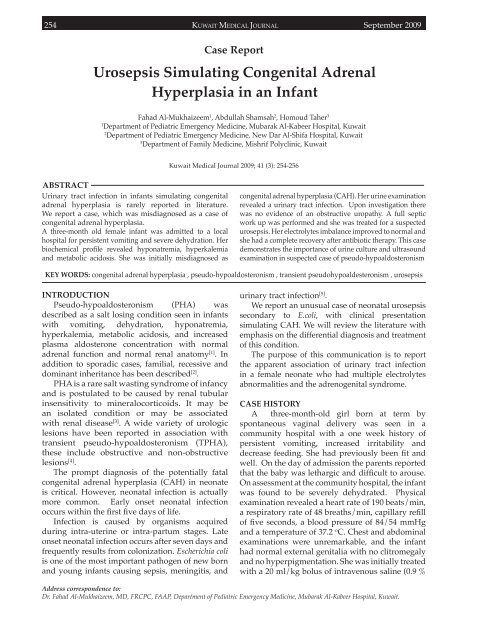Vol 41 # 3 September 2009 - Kma.org.kw
Vol 41 # 3 September 2009 - Kma.org.kw
Vol 41 # 3 September 2009 - Kma.org.kw
You also want an ePaper? Increase the reach of your titles
YUMPU automatically turns print PDFs into web optimized ePapers that Google loves.
254<br />
KUWAIT MEDICAL JOURNAL <strong>September</strong> <strong>2009</strong><br />
Case Report<br />
Urosepsis Simulating Congenital Adrenal<br />
Hyperplasia in an Infant<br />
Fahad Al-Mukhaizeem 1 , Abdullah Shamsah 2 , Homoud Taher 3<br />
1<br />
Department of Pediatric Emergency Medicine, Mubarak Al-Kabeer Hospital, Kuwait<br />
2<br />
Department of Pediatric Emergency Medicine, New Dar Al-Shifa Hospital, Kuwait<br />
3<br />
Department of Family Medicine, Mishrif Polyclinic, Kuwait<br />
Kuwait Medical Journal <strong>2009</strong>; <strong>41</strong> (3): 254-256<br />
ABSTRACT<br />
Urinary tract infection in infants simulating congenital<br />
adrenal hyperplasia is rarely reported in literature.<br />
We report a case, which was misdiagnosed as a case of<br />
congenital adrenal hyperplasia.<br />
A three-month old female infant was admitted to a local<br />
hospital for persistent vomiting and severe dehydration. Her<br />
biochemical profile revealed hyponatremia, hyperkalemia<br />
and metabolic acidosis. She was initially misdiagnosed as<br />
congenital adrenal hyperplasia (CAH). Her urine examination<br />
revealed a urinary tract infection. Upon investigation there<br />
was no evidence of an obstructive uropathy. A full septic<br />
work up was performed and she was treated for a suspected<br />
urosepsis. Her electrolytes imbalance improved to normal and<br />
she had a complete recovery after antibiotic therapy. This case<br />
demonstrates the importance of urine culture and ultrasound<br />
examination in suspected case of pseudo-hypoaldosteronism<br />
KEY WORDS: congenital adrenal hyperplasia , pseudo-hypoaldosteronism , transient pseudohypoaldesteronism , urosepsis<br />
INTRODUCTION<br />
Pseudo-hypoaldosteronism (PHA) was<br />
described as a salt losing condition seen in infants<br />
with vomiting, dehydration, hyponatremia,<br />
hyperkalemia, metabolic acidosis, and increased<br />
plasma aldosterone concentration with normal<br />
adrenal function and normal renal anatomy [1] . In<br />
addition to sporadic cases, familial, recessive and<br />
dominant inheritance has been described [2] .<br />
PHA is a rare salt wasting syndrome of infancy<br />
and is postulated to be caused by renal tubular<br />
insensitivity to mineralocorticoids. It may be<br />
an isolated condition or may be associated<br />
with renal disease [3] . A wide variety of urologic<br />
lesions have been reported in association with<br />
transient pseudo-hypoaldosteronism (TPHA),<br />
these include obstructive and non-obstructive<br />
lesions [4] .<br />
The prompt diagnosis of the potentially fatal<br />
congenital adrenal hyperplasia (CAH) in neonate<br />
is critical. However, neonatal infection is actually<br />
more common. Early onset neonatal infection<br />
occurs within the first five days of life.<br />
Infection is caused by <strong>org</strong>anisms acquired<br />
during intra-uterine or intra-partum stages. Late<br />
onset neonatal infection occurs after seven days and<br />
frequently results from colonization. Escherichia coli<br />
is one of the most important pathogen of new born<br />
and young infants causing sepsis, meningitis, and<br />
urinary tract infection [5] .<br />
We report an unusual case of neonatal urosepsis<br />
secondary to E.coli, with clinical presentation<br />
simulating CAH. We will review the literature with<br />
emphasis on the differential diagnosis and treatment<br />
of this condition.<br />
The purpose of this communication is to report<br />
the apparent association of urinary tract infection<br />
in a female neonate who had multiple electrolytes<br />
abnormalities and the adrenogenital syndrome.<br />
CASE HISTORY<br />
A three-month-old girl born at term by<br />
spontaneous vaginal delivery was seen in a<br />
community hospital with a one week history of<br />
persistent vomiting, increased irritability and<br />
decrease feeding. She had previously been fit and<br />
well. On the day of admission the parents reported<br />
that the baby was lethargic and difficult to arouse.<br />
On assessment at the community hospital, the infant<br />
was found to be severely dehydrated. Physical<br />
examination revealed a heart rate of 190 beats/min,<br />
a respiratory rate of 48 breaths/min, capillary refill<br />
of five seconds, a blood pressure of 84/54 mmHg<br />
and a temperature of 37.2 o C. Chest and abdominal<br />
examinations were unremarkable, and the infant<br />
had normal external genitalia with no clitromegaly<br />
and no hyperpigmentation. She was initially treated<br />
with a 20 ml/kg bolus of intravenous saline (0.9 %<br />
Address correspondence to:<br />
Dr. Fahad Al-Mukhaizeem, MD, FRCPC, FAAP, Department of Pediatric Emergency Medicine, Mubarak Al-Kabeer Hospital, Kuwait.
















